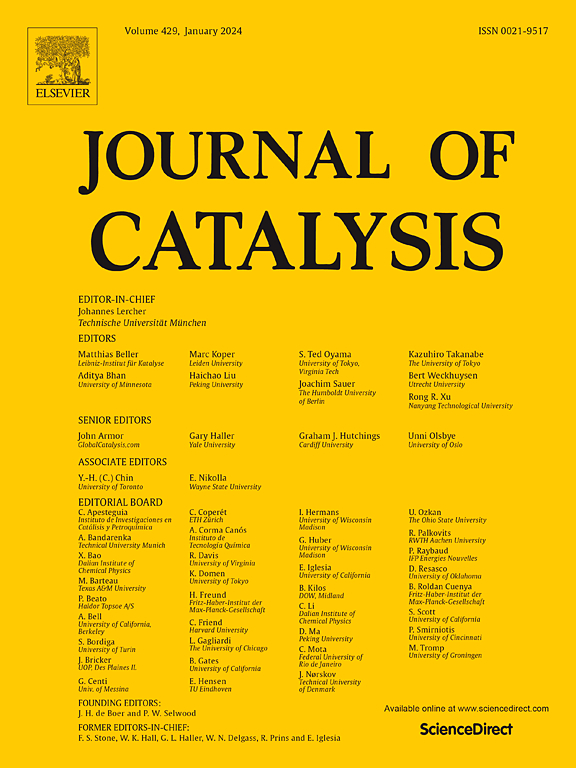Simultaneous removal of ethane and NOx over Ce-MnO2 catalysts: Insights into dual-functional mechanisms and temperature-dependent interactions
IF 6.5
1区 化学
Q2 CHEMISTRY, PHYSICAL
引用次数: 0
Abstract
Ce-X-MnO2 (X = α, β, γ, δ) catalysts with four MnO2 structures were synthesized for simultaneous ethane and NOx removal. Ce-γ-MnO2 exhibited the highest performance, achieving > 80 % conversion for ethane (276 °C) and NO (120–330 °C). Various characterizations demonstrated a correlation between the activity and the abundance of Lewis acid-base pairs, with a higher amount of these species linked to better reactivity. The Mn4+-O-Ce sites were identified as active centers: ethane oxidation followed the MvK mechanism, while NH3-SCR proceeded via both L-H and E-R pathways. The inhibition of ethane oxidation by NH3-SCR reactants was primarily due to NH3 suppressing ethane adsorption and competing for oxygen species. As ethane activation accelerated above 200 °C, NO2 generated from NO oxidation tended to donate reactive oxygen, reconstructing the surface oxygen species and concurrently mitigating the NH3 inhibition. Additionally, NO2 dissociation released NO, further decreasing NO conversion at higher temperatures. Below 200 °C, new Lewis and Brønsted acid sites were generated during ethane activation, promoting NH3 adsorption and improving low-temperature SCR activity.

在Ce-MnO2催化剂上同时去除乙烷和NOx:对双功能机制和温度依赖相互作用的见解
合成了具有四种MnO2结构的Ce-X-MnO2 (X = α, β, γ, δ)催化剂,用于同时脱除乙烷和NOx。Ce-γ-MnO2表现出最高的性能,对乙烷(276 °C)和NO(120-330 °C)的转化率达到 >; 80 %。各种表征表明活性与刘易斯酸碱对的丰度之间存在相关性,这些物种的数量越多,反应性越好。Mn4+-O-Ce位点被确定为活性中心:乙烷氧化遵循MvK机制,而NH3-SCR通过L-H和E-R途径进行。NH3- scr反应物对乙烷氧化的抑制主要是由于NH3抑制了乙烷的吸附和对氧的竞争。在200 °C以上,随着乙烷活化加速,NO氧化产生的NO2倾向于提供活性氧,重建表面氧,同时减轻NH3的抑制作用。此外,NO2解离释放NO,进一步降低了NO在高温下的转化率。在200 °C以下,乙烷活化过程中产生新的Lewis和Brønsted酸位,促进了NH3吸附,提高了低温SCR活性。
本文章由计算机程序翻译,如有差异,请以英文原文为准。
求助全文
约1分钟内获得全文
求助全文
来源期刊

Journal of Catalysis
工程技术-工程:化工
CiteScore
12.30
自引率
5.50%
发文量
447
审稿时长
31 days
期刊介绍:
The Journal of Catalysis publishes scholarly articles on both heterogeneous and homogeneous catalysis, covering a wide range of chemical transformations. These include various types of catalysis, such as those mediated by photons, plasmons, and electrons. The focus of the studies is to understand the relationship between catalytic function and the underlying chemical properties of surfaces and metal complexes.
The articles in the journal offer innovative concepts and explore the synthesis and kinetics of inorganic solids and homogeneous complexes. Furthermore, they discuss spectroscopic techniques for characterizing catalysts, investigate the interaction of probes and reacting species with catalysts, and employ theoretical methods.
The research presented in the journal should have direct relevance to the field of catalytic processes, addressing either fundamental aspects or applications of catalysis.
 求助内容:
求助内容: 应助结果提醒方式:
应助结果提醒方式:


